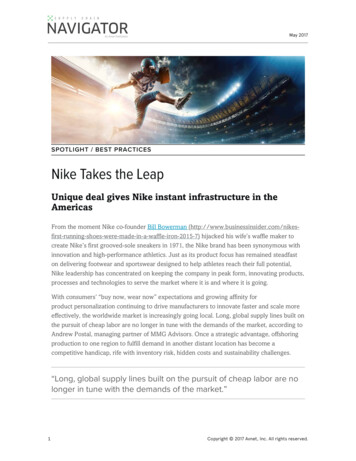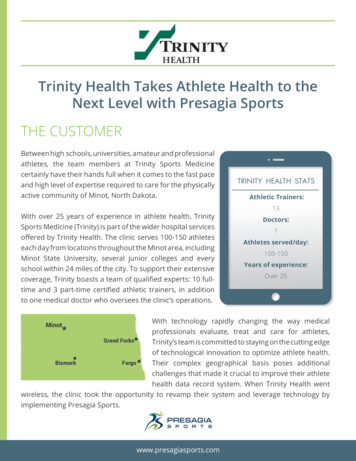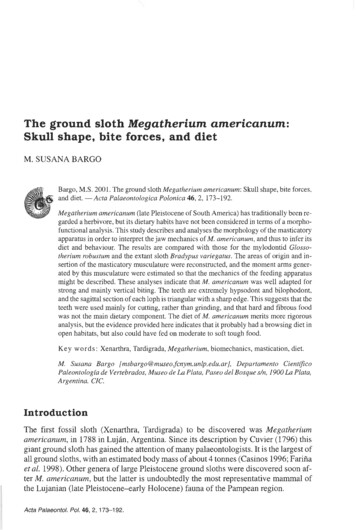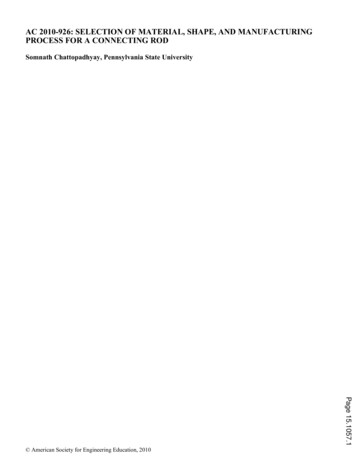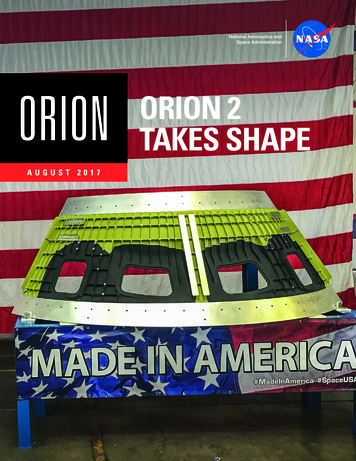
Transcription
ORIONAUGUST 2017ORION 2TAKES SHAPE
ORION’S MONTHLY HIGHLIGHTSORION ASTRONAUT WINDOW PANEL SHIPS OUTORION VISITS THE BIG APPLEEM-1 SPACECRAFT POWERS UPORION SHARES JOURNEY TOMARS AT OSHKOSH AIR SHOWWHAT IT TAKES TO BE AN ORION INTERNAugust 2017 HighlightsCATCH A GLIMPSE OF THE SOLAR ECLIPSESUPPLIER SPOTLIGHT: DEEP SPACE SYSTEMSOrion
ORION’S ASTRONAUTWINDOW PANEL SHIPS OUTWhen the first crew of astronauts fliesaboard the Orion spacecraft, they will beable to look through a window and viewthe moon and Earth from their deep-spacevantage point. The window panel that willprovide that view is ready for shipment toNASA. AMRO Fabricating Corp., of South ElMonte, California, has completed a sectionof the Orion pressure vessel, or underlyingstructure of the spacecraft that will sendastronauts farther than humans have evertraveled before on Exploration Mission-2.August 2017 HighlightsOrion3
Orion’s four windows are contained in one of three conepanels that AMRO is manufacturing for NASA and Orionprime contractor, Lockheed Martin. The spacecraft’spressure vessel has seven structural elements, includingthe three cone panels. AMRO shipped the panel toNASA’s Michoud Assembly Facility in New Orleansat the end of August, where it will be outfitted withstrain gauges and wiring for monitoring purposes andjoined together with other pieces of the pressure vesselscheduled to arrive at Michoud in the coming months.The pressure vessel forms the sealed environmentinside where astronauts will live and the structure uponwhich all the other elements of the spacecraft are builtand integrated. The components of Orion’s pressurevessel are joined using the friction-stir welding process,which bonds the pieces by transforming metals froma solid into a plastic-like state and then forging a bondbetween the two metal components. Once all pressurevessel elements are welded together, the spacecraft willbe sent to NASA’s Kennedy Space Center in Florida foroutfitting, processing and launch.Other than several small changes to allow for interfaceswith crew equipment or mounting of hardware specificto EM-2, the overall structure, manufacturing processand mass of the pressure vessel is the same as it is forthe structure that will fly on the first mission of Orion andSLS, now that engineers have optimized the design ofOrion’s structure. Engineers are making progress on theEM-1 spacecraft, currently being assembled at Kennedyahead of its 2019 launch.Family owned AMRO Fabricating Corp. celebrated thecompletion of the Exploration Mission-2 crew modulewindow panel at their Made In America themed event onAugust 9.Read more: bit.ly/DailyNewsAMRONNASA Astronaut Lee Morin, NASA and Lockheed representatives and VIP guests joined more than 100 AMRO employees on the factory floor for thismilestone event complete with American flags, apple pie and ice cream. Representatives from the offices of Sens. Diane Feinstein and Kamala Harrisattended along with South El Monte Mayor Gloria Olmos and City Council Member Richard Angel. NASA Associate Administrator for Small BusinessPrograms Glenn Delgado also attended the event with small business representatives for NASA centers from across the country.August 2017 HighlightsOrion4
ORION EM-1 SPACECRAFTPOWERS UPHurtling beyond the moon at a speedy 25,000 mph for athree-week mission requires a space processor capableof operating with guaranteed reliability, in a high radiationenvironment tens of thousands of miles in deep space,at 480,000,000 instructions per second to executethousands of commands and sequences for controllingthe hundreds of spacecraft systems and components toensure crew safety and mission success.To ensure everything performs as planned, the Orionspacecraft destined for Exploration Mission-1 wassuccessfully powered up for the first time in Augustin Orion’s spacecraft factory, the Neil ArmstrongOperations and Checkout Building at NASA’s KennedySpace Center in Florida.August 2017 HighlightsDuring the initial power-on tests, engineers andtechnicians connected the vehicle managementcomputers to Orion’s power and data units to ensurethe systems communicate precisely with one anotherto accurately route power and functional commandsthroughout the spacecraft for the duration of a deepspace exploration mission. In spaceflight, Orion willgenerate power through its four solar array wingswhich collectively hold about 15,000 solar cells thatcan harness enough electricity to power eight threebedroom homes. The power and data units thendistribute that power as needed throughout thespacecraft.Learn more: bit.ly/LMOrionIPOOrion5
ORION SHARES JOURNEYTO MARS AT OSHKOSHORION VISITSTHE BIG APPLEThe Orion and Space Launch System (SLS) programs hada big presence at the recent EAA AirVenture Oshkosh AirShow in Oshkosh, Wisconsin. Prime contractors helpingto build Orion and SLS around the country such as OrbitalATK, Aerojet Rocketdyne, Lockheed Martin and Boeingshared the story of NASA’s deep space explorationefforts with more than 550,000 guests who attendedthe air show. Their exhibit included an Oculus Rift Marsvirtual experience, a photo booth and several panelpresentations, including a Women in Space panel whichfeatured Astronaut Janet Kavandi and four other womenwith jobs dedicated to space and aerospace.Members of the Orion Program participated in the 2017Intrepid Science and Space Festival held in New York Cityon Aug. 3-6. The festival is a four-day celebration of scienceand space that takes place annually in mid-summer at theIntrepid Sea, Air and Space Museum which is housed on aWWII-era aircraft carrier on Pier 86 in mid-town Manhattan.Throughout the event, more than 15,000 people had theopportunity to participate in featured lectures, presentations,hands-on activities, special exhibitions and a variety of otherexperiences for all ages. The event provides opportunitiesfor a large and diverse audience to positively engage withNASA and other informal education groups to enhancescience, engineering, technology and math. NASA OrionProgram Manager Mark Kirasich also conducted interviewswith several media outlets while at the event.Read more about the Oshkosh Women in Space Panel:bit.ly/FoxCitiesOshKoshRead interview with Orion Program Manager Mark Kirasich:bit.ly/SpaceFlightIntrepidAugust 2017 HighlightsOrion6
CATCH A GLIMPSEOF THE SOLARECLIPSESee pictures from around the l/August 2017 HighlightsJust as the moon lined up with the sun for the solareclipse that was seen across the United States, inthe future, NASA will monitor the alignment of Earthand Mars to ensure the best path is taken as Orionjourneys through deep space. Whether viewers werein the path of total eclipse, or were only able to seepart of the sun blocked out by the moon, Americansshared their views and memories of the event.Orion7
SUPPLIER SPOTLIGHTDEEP SPACE SYSTEMS INC.Located in Littleton, Colorado, Deep Space Systems Inc. (DSSI)is an engineering services contractor and vendor for the Orionengineering camera system. DSSI has 15 employees who work onsystems, electrical, mechanical software and test engineering forOrion. The camera system captures all important mission eventsboth inside and outside the spacecraft.August 2017 HighlightsDSSI provides Orion with 11 cameras and two cameracontrollers. During missions, they will document separations,jettisons and deployments, even placing cameras on the tips ofthe spacecraft’s solar arrays. The team said, “Orion representsthe very best of the aspirations and intentions of the peopleof the United States. We are all inspired by a shared nationalvision to boldly explore the space frontier and the limits of whatwe as a people and a species are capable of doing.” DSSIis also developing compact, high performance cameras forgovernment and commercial applications.Orion8
BUILDING ORIONAIRBUS DEFENCE AND SPACESharing information prior to their AMA are internsSam Goldman, Abbey Johnson, Bailey Sikorski andCong Bui.Airbus Defence and Space is managing the development and construction of theOrion service module for the European Space Agency. More than 20,000 parts andcomponents will be installed in the space flight model, from electrical equipment torocket engines, solar panels, fuel tanks and life support materials, as well as 11 kmof cables and tubes. The integration of the first flight model is currently underwayand the start of the integration of the second flight model is planned for 2018.In this video, meet some of the engineers and technicians at their Bremen facility,where all the service module integration and testing takes place, as they bringtogether the expertise and components from their partners and suppliers from allacross Europe.Heike Nupnau, Electrician in the cleanroom, ArianeGroupDragos Alexandru Paun, Orion-ESM Propulsion EngineerMarcel Petke, Team Lead Space Vehicles Integration, ArianeGroupHend Kamoun-Rosenko, Propulsion Engineer ArianeGroupHenning Schoenbeck , Head Design Engineer for Orion-ESMWatch the video: bit.ly/2wlCxO5FOLLOW THE PROGRESS OFNASA’S NEW SPACECRAFTFOR HUMAN EXPLORATION:Twitter . . . . . . . . . . . . . . . Twitter.com/NASA OrionWHAT IT TAKESTO BE AN ORIONINTERNFour interns at Lockheed Martinnear Denver, Colorado, who spentthe summer working on Oriontechnology, recently participated ina Reddit AMA. During their summerterm they worked on various projectsinvolved with Orion’s integration andtesting, flight software and softwareintegration. After learning what ittakes to intern at a large company,and what goes into developing aspacecraft as innovative as Orion,they answered questions to showwhat their experiences taught them.See their responses:bit.ly/InternAMA17SEPTEMBERTesting Orion’s structure in ColoradoFacebook . . . . . . . . . . . . Facebook.com/NASAOrionParachute test in ArizonaFlickr . . . . . . . . . . . . . . . . Flickr.com/NASAOrionSupplier Conference in IndianaGoogle . . . . . . . . . . . . . Plus.Google.com/ NASAorionHurricane Helpers in Action
Just as the moon lined up with the sun for the solar eclipse that was seen across the United States, in the future, NASA will monitor the alignment of Earth and Mars to ensure the best path is taken as Orion journeys through deep space. Whether viewers were in the path of
